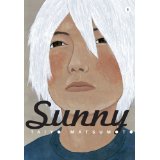It makes me feel good that there are still new series coming out from Viz in the Viz Signature imprint. Sunny by Taiyo Matsumoto is also an addition to the trend of nicely packaged manga hardcovers. With a slightly larger trim size (the same as the other IKKI titles) and color pages before most chapters, this is a volume that will delight manga collectors looking for something nicer than the average paperback. I’ve only read Blue Spring by Matsumoto before, I really need to get around to reading Tekkon Kinkreet.
Sunny is written in one of my favorite fiction formats – a collection of interrelated short stores with shifting main characters that are all tied together. The Sunny of the title of the book refers to a broken down old Nissan Sunny car that sits in the back of a group home for abandoned children. The Sunny is a secret hideout, place to stash porn and other illicit materials, and a means of escape for a group of kids that doesn’t have much security or fun in their daily lives. The volume opens with a brief glimpse of foster home chaos, quickly inter cut with a scene showing the imagination of Haruo, who sits in the car imagining that he’s bleeding out in the desert like a tragic movie tough guy. Haruo’s reverie is abruptly interrupted by Junsuke, an overly hyper snotty-nosed kid who eagerly announces that there’s a new arrival in the house. The readers of Sunny and the new kid Sei both get an abrupt introduction to the children’s home as Sei goes through the house and sits in the Sunny with Haruo and Junsuke. When Sei says that his mom is going to pick him up before summer Haruo says, “No way you’re goin home. You got dumped.”
Sunny captures Haruo’s frustration and anger about his own situation, combined with his helplessness about being able to change anything. Junsuke struggles with his instinct to grab anything shiny, even stealing from his classmates at times. While Haruo is a central viewpoint character, Sunny fluidly moves among different points of view, showing Megumu’s concern for a dead cat and the real-world concerns of older kid Kenji. While there’s a lot of hopelessness in the lives of the kids who live at the home, they also stick up for each other and come together when one of them goes missing.
Matsumoto has a scratchy pen and ink style in his drawings, which incorporate cartoonish elements like circles for rosy cheeks. Washes of ink in varying intensity and hand-drawn textures instead of screentones give Sunny a hand-crafted feel that stands out among more corporate glossy manga. Matsumoto’s detailed backgrounds firmly establish the neighborhood the kids live in, as well as the run-down environment of their house. Overall, Sunny is exactly what I’d expect from the Viz Signature line – a nuanced work that is set apart from more commercial manga due to its artistic and literary value .

One reply on “Sunny, Vol. 1 by Taiyo Matsumoto”
[…] 1 of Rurouni Kenshin: Restoration (I Reads You) Naru on Silent Voice (Organization ASG) Anna N. on vol. 1 of Sunny (Manga Report) Kristin on vol. 10 of Tenjho Tenge: Full Contact Edition (Comic […]